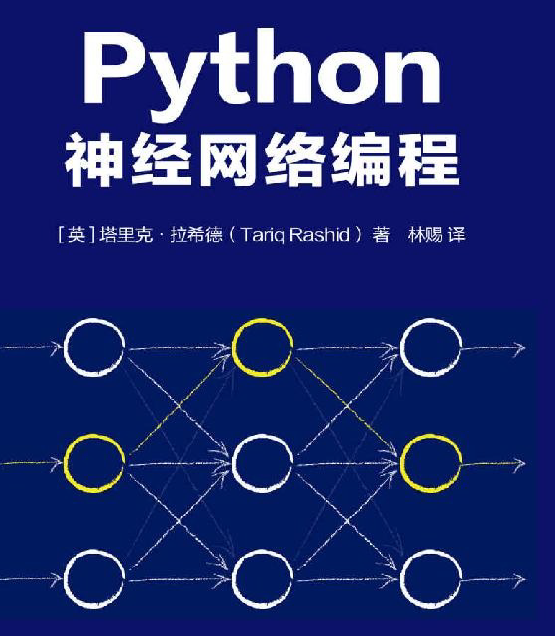声明:本文章为阅读书籍《Python神经网络编程》而来,代码与书中略有差异,书籍封面:

源码
若要本地运行,请更改源码中图片与数据集的位置,环境为 Python3.6x.
1 import numpy as np 2 import scipy.special as ss 3 import matplotlib.pyplot as plt 4 import imageio as im 5 import glob as gl 6 7 8 class NeuralNetwork: 9 # initialise the network 10 def __init__(self, inputnodes, hiddennodes, outputnodes, learningrate): 11 # set number of each layer 12 self.inodes = inputnodes 13 self.hnodes = hiddennodes 14 self.onodes = outputnodes 15 self.wih = np.random.normal(0.0, pow(self.inodes, -0.5), (self.hnodes, self.inodes)) 16 self.who = np.random.normal(0.0, pow(self.hnodes, -0.5), (self.onodes, self.hnodes)) 17 # learning rate 18 self.lr = learningrate 19 # activation function is sigmoid 20 self.activation_function = lambda x: ss.expit(x) 21 pass 22 23 # train the neural network 24 def train(self, inputs_list, targets_list): 25 inputs = np.array(inputs_list, ndmin=2).T 26 targets = np.array(targets_list, ndmin=2).T 27 hidden_inputs = np.dot(self.wih, inputs) 28 hidden_outputs = self.activation_function(hidden_inputs) 29 final_inputs = np.dot(self.who, hidden_outputs) 30 final_outputs = self.activation_function(final_inputs) 31 # errors 32 output_errors = targets - final_outputs 33 # b-p algorithm 34 hidden_errors = np.dot(self.who.T, output_errors) 35 # update weight 36 self.who += self.lr * np.dot((output_errors * final_outputs * (1.0 - final_outputs)), 37 np.transpose(hidden_outputs)) 38 self.wih += self.lr * np.dot((hidden_errors * hidden_outputs * (1.0 - hidden_outputs)), np.transpose(inputs)) 39 pass 40 41 # query the neural network 42 def query(self, inputs_list): 43 inputs = np.array(inputs_list, ndmin=2).T 44 hidden_inputs = np.dot(self.wih, inputs) 45 hidden_outputs = self.activation_function(hidden_inputs) 46 final_inputs = np.dot(self.who, hidden_outputs) 47 final_outputs = self.activation_function(final_inputs) 48 return final_outputs 49 50 # numbers 51 52 53 input_nodes = 784 54 hidden_nodes = 100 55 output_nodes = 10 56 57 # learning rate 58 learning_rate = 0.2 59 60 # creat instance of neural network 61 global n 62 n = neuralNetwork(input_nodes, hidden_nodes, output_nodes, learning_rate) 63 64 # file read only ,root of the file 65 training_data_file = open(r"C:\Users\ELIO\Desktop\mnist_train.txt", 'r') 66 training_data_list = training_data_file.readlines() 67 training_data_file.close() 68 69 # train the neural network 70 epochs = 5 71 for e in range(epochs): 72 for record in training_data_list: 73 all_values = record.split(',') 74 # scale and shift the inputs 75 inputs = (np.asfarray(all_values[1:]) / 255.0 * 0.99) + 0.01 76 targets = np.zeros(output_nodes) + 0.01 77 # all_values[0] is the target label for this record 78 targets[int(all_values[0])] = 0.99 79 n.train(inputs, targets) 80 pass 81 pass 82 83 # load the file into a list 84 test_data_file = open(r"C:\Users\ELIO\Desktop\mnist_train_100.csv.txt", 'r') 85 test_data_list = test_data_file.readlines() 86 test_data_file.close() 87 88 # test the neural network 89 # score for how well the network performs 90 score = [] 91 92 # go through all the records 93 for record in test_data_list: 94 all_values = record.split(',') 95 # correct answer is the first value 96 correct_label = int(all_values[0]) 97 # scale and shift the inputs 98 inputs = (np.asfarray(all_values[1:]) / 255.0 * 0.99) + 0.01 99 # query the network 100 outputs = n.query(inputs) 101 # the index of the highest value corresponds to the label 102 label = np.argmax(outputs) 103 # append correct or incorrect to list 104 if (label == correct_label): 105 score.append(1) 106 else: 107 score.append(0) 108 pass 109 pass 110 # module1 CORRECT-RATE 111 # calculate the score, the fraction of correct answers 112 score_array = np.asarray(score) 113 print("performance = ", score_array.sum() / score_array.size) 114 115 # module2 TEST MNIST 116 all_values = test_data_list[0].split(',') 117 print(all_values[0]) 118 image_array = np.asfarray(all_values[1:]).reshape((28, 28)) 119 plt.imshow(image_array, cmap='Greys', interpolation='None') 120 plt.show() 121 122 # module3 USE YOUR WRITING 123 # own image test data set 124 own_dataset = [] 125 for image_file_name in gl.gl(r'C:\Users\ELIO\Desktop\5.png'): 126 print("loading ... ", image_file_name) 127 # use the filename to set the label 128 label = int(image_file_name[-5:-4]) 129 # load image data from png files into an array 130 img_array = im.imread(image_file_name, as_gray=True) 131 # reshape from 28x28 to list of 784 values, invert values 132 img_data = 255.0 - img_array.reshape(784) 133 # then scale data to range from 0.01 to 1.0 134 img_data = (img_data / 255.0 * 0.99) + 0.01 135 print(np.min(img_data)) 136 print(np.max(img_data)) 137 # append label and image data to test data set 138 record = np.append(label, img_data) 139 print(record) 140 own_dataset.append(record) 141 pass 142 all_values = own_dataset[0] 143 print(all_values[0])
数据集,实验图片
链接:百度网盘
提取码:1vbq